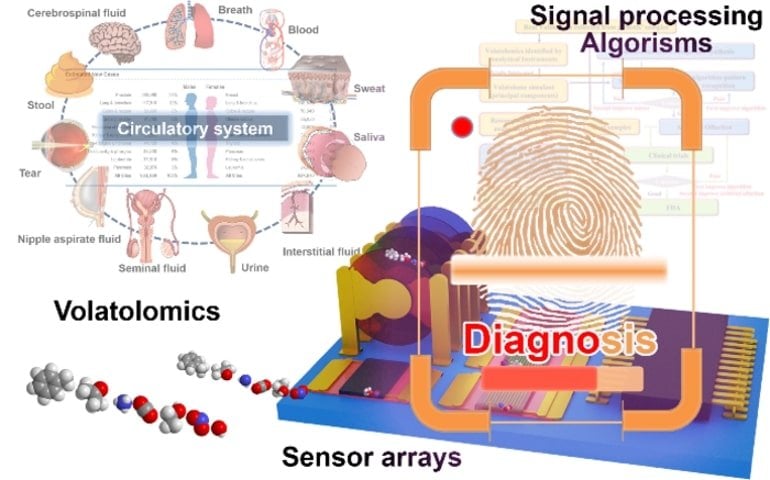Summary: A new robotic system can identify volatile organic compounds associated with diseases by analyzing bodily emissions.
Source: Tsinghua University Press
Scientists are working on diagnostic techniques that could sniff out chemical compounds from breath, sweat, tears and other bodily emissions and that act as fingerprints of thousands of diseases.
But to take this concept—known as ‘volatolomics’—and its associated diagnostic technologies from the laboratory through to commercialisation will require collaboration across a great many disciplines.
This includes researchers such as chemists, materials scientists and electrical engineers who rarely speak the same language and are largely unfamiliar with each other’s findings.
A comprehensive new review of this still very young field aims to be a bridge between the many disparate actors involved.
When you smell a perfume, encounter the scent of flowers or spices, or suffer through a whiff of pollutants, what your body is actually sensing are volatile organic compounds, chemicals that have a low boiling point and thus evaporate easily. That is, they are volatile, and these chemicals as a group are called volatile organic compounds or VOCs.
All organisms deliberately release VOCs for various purposes including defence, communication and reproduction. But VOCs are also released incidentally as part of all biological processes, including processes related to illness. Those released are also unique to each of these processes. This means that there is a particular VOC “signature” or “fingerprint” to every disease.
Such VOCs related to disease are also released long before people might be aware that anything is wrong with them, and thus also long before any doctor can carry out a diagnostic technique, whether via blood tests, X-ray, tissue samples or any other examination or lab work.
A great many diseases, not least cancers, are much more easily treated the earlier they are diagnosed. Thus if researchers and clinicians are able to categorize the VOC fingerprint of different illnesses, and engineers able to develop devices that could rapidly identify such fingerprints, this could potentially deliver a revolution in medicine’s ability to diagnose and ultimately treat illnesses.
As an added bonus, the lack of need for any invasive procedure from such diagnosis via ‘sniffing’ means that it would be painless as well, unlike far too many existing diagnostic techniques.
This is the main idea behind the concept of the very young field of volatolomics, or analysis of the entirety of the set of VOCs that someone exhales in their breath or emits from their skin, sweat, tears, or indeed via any other bodily mechanism.
While the field of volatolomics is new, the concept of diagnosis of disease via a sniffing of someone’s breath actually dates back to the Ancient Greek physician Hippocrates and legendary Ancient Chinese doctor Bian Que, and even over the last 50 years, thousands of VOC fingerprints of diseases have been identified. But until now, we have lacked advanced diagnostic technologies to do much with this information.
What has prompted the explosion of research into volatolomics in the last few years is the development of precisely the sort of technologies, including data mining of vast quantities of data (“Big Data”), machine learning and nanomaterial sensors, that potentially can rapidly and accurately identify these VOC fingerprints in the face of enormous complexity and confounding factors such as the VOCs released from food, drinking, and environmental pollution, and do so no matter which bodily sources they come from.
“But the field is so young, and draws in researchers from many fields such as chemistry, electrical engineering, computer science, materials science, and of course clinicians who deal with patients every day, who are unused to speaking to each other, who typically employ different methodologies, and who often do not even use the same terms,” said Yun Qian, a co-author of the review and researcher with the Cancer Center of Zhejiang University.
“So we brought a bunch of us from these various disciplines together to write a comprehensive review paper that we hope will work as a bridge connecting each other’s expertise in this sprawling field.”
The authors first summarized all the VOCs that are associated with different diseases from all possible bodily sources in a sort of encyclopedia of illness volatiles.
“This part of the review was crucial, as such a list of targets has been highly sought after by the chemists, materials scientists, and electrical engineers in particular,” added Mingshui Yao, another of the authors and researcher at the State Key Laboratory of Multi-phase Complex Systems with the Chinese Academy of Sciences.

“They needed to know what the fingerprints or ‘biomarkers’ are that they are designing their diagnostic equipment for. Now they can just look this up.”
In addition, the review gives a commentary on the state of play of the technologies involved with volatolomics analysis, in particular advanced “electronic nose” (E-nose) and “photonic nose” (P-nose) devices for VOC detection.
In describing the current situation, what obstacles developers of these “robot noses” face, and offering future perspectives, the reviewers aim to both give doctors a good understanding of such cutting-edge detection technologies, and to give all volatolomics researchers an overview of where the main research gaps lie, and so enable a narrowing of the still considerable gap between lab bench and commercial deployment.
The authors hope that with the review as a reference point for everyone involved, these gaps can be filled and technology development obstacles overcome, especially with respect to better VOC absorbing materials, selective sensing materials, advanced sensor structures, and smart data-processing methods.
The ultimate goal is to one day be able to deploy volatolomics as the golden standard in clinical diagnostics.
About this robotics research news
Author: Yao Meng
Source: Tsinghua University Press
Contact: Yao Meng – Tsinghua University Press
Image: The image is credited to Nano Research, Tsinghua University Press
Original Research: Closed access.
“Volatolomics in Healthcare and Its Advanced Detection Technology” by Yun Qian et al. Nano Research
Abstract
Volatolomics in Healthcare and Its Advanced Detection Technology
Various diseases increasingly challenge the health status and life quality of human beings. Volatolome emitted from patients has been considered as a potential family of markers, volatolomics, for diagnosis/screening. There are two fundamental issues of volatolomics in healthcare.
On one hand, the solid relationship between the volatolome and specific diseases needs to be clarified and verified. On the other hand, effective methods should be explored for the precise detection of volatolome. Several comprehensive review articles had been published in this field.
However, a timely and systematical summary and elaboration is still desired. In this review article, the research methodology of volatolomics in healthcare is critically considered and given out, at first. Then, the sets of volatolome according to specific diseases through different body sources and the analytical instruments for their identifications are systematically summarized.
Thirdly, the advanced electronic nose and photonic nose technologies for volatile organic compounds (VOCs) detection are well introduced. The existed obstacles and future perspectives are deeply thought and discussed.
This article could give a good guidance to researchers in this interdisciplinary field, not only understanding the cutting-edge detection technologies for doctors (medicinal background), but also making reference to clarify the choice of aimed VOCs during the sensor research for chemists, materials scientists, electronics engineers, etc.






